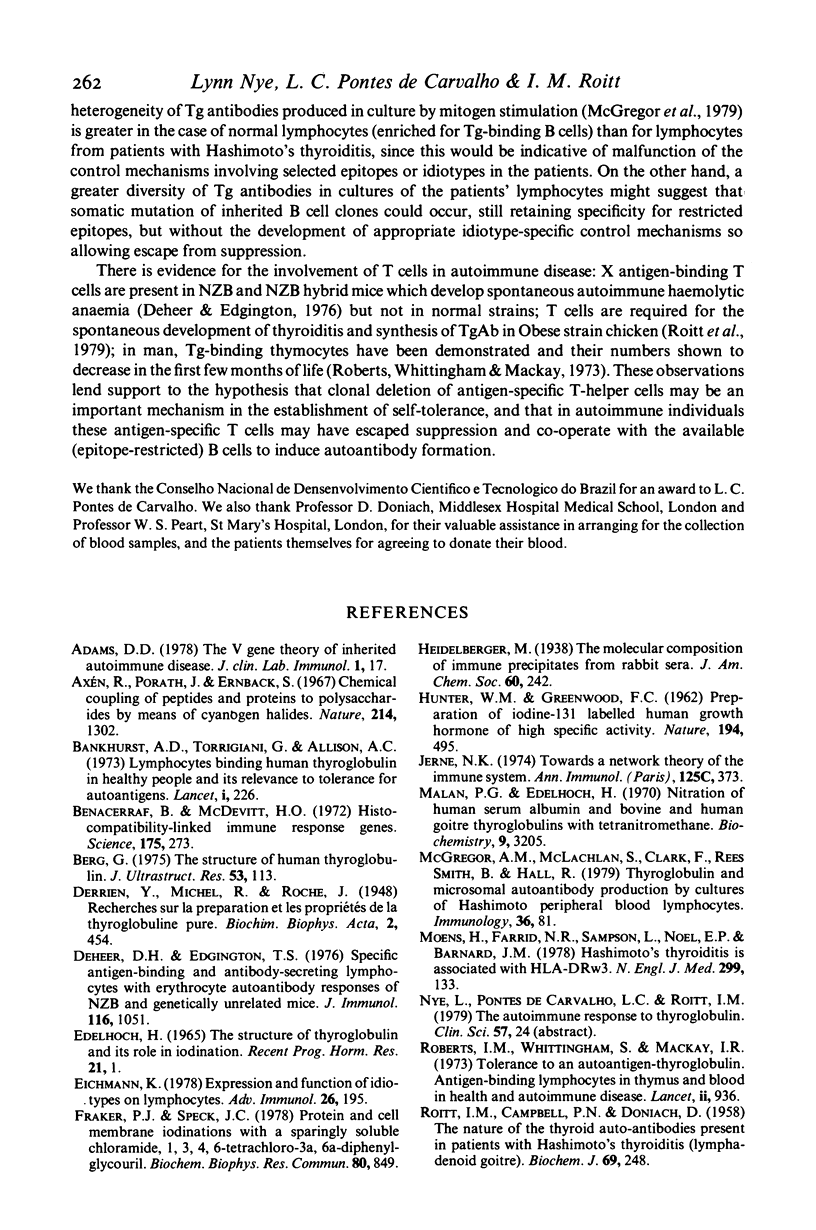Abstract
Fragments of thyroglobulin containing the autoreactive epitopes were prepared by an existing procedure, plus an ion-exchange chromatography step which increased their purity. Before purification, 39% of the fragmental material was bound by rabbit anti-human thyroglobulin whereas only 8% was bound by autoantibody, thus confirming earlier reports of more limited epitopes for human autoantibodies than heterologous antibody. Thyroglobulin autoantibodies in the globulin fractions from six human sera showed between 70 and 100% cross-reaction with one another, indicating that the majority of antibodies are directed against the same epitopes. The data are consistent with an estimated of two distinct major epitopic specificities with occasional sera having antibodies directed against a third site. Chemical modification of tyrosine residues by iodination did not inhibit the binding of thyroglobulin to either human autoantibodies or rabbit anti-human thyroglobulin; thus tyrosine residues do not contribute significantly to the epitopes for either auto- or heteroantibodies.
Full text
PDF











Selected References
These references are in PubMed. This may not be the complete list of references from this article.
- Axén R., Porath J., Ernback S. Chemical coupling of peptides and proteins to polysaccharides by means of cyanogen halides. Nature. 1967 Jun 24;214(5095):1302–1304. doi: 10.1038/2141302a0. [DOI] [PubMed] [Google Scholar]
- Bankhurst A. D., Torrigiani G., Allison A. C. Lymphocytes binding human thyroglobulin in healthy people and its relevance to tolerance for autoantigens. Lancet. 1973 Feb 3;1(7797):226–230. doi: 10.1016/s0140-6736(73)90066-4. [DOI] [PubMed] [Google Scholar]
- Benacerraf B., McDevitt H. O. Histocompatibility-linked immune response genes. Science. 1972 Jan 21;175(4019):273–279. doi: 10.1126/science.175.4019.273. [DOI] [PubMed] [Google Scholar]
- Berg G. The structure of human thyroglobulin. J Ultrastruct Res. 1975 Oct;53(1):113–118. doi: 10.1016/s0022-5320(75)80090-6. [DOI] [PubMed] [Google Scholar]
- DeHeer D. H., Edgington T. S. Specific antigen-binding and antibody-secreting lymphocytes associated with the erythrocyte autoantibody responses of NZB and genetically unrelated mice. J Immunol. 1976 Apr;116(4):1051–1058. [PubMed] [Google Scholar]
- EDELHOCH H. THE STRUCTURE OF THYROGLOBULIN AND ITS ROLE IN IODINATION. Recent Prog Horm Res. 1965;21:1–31. [PubMed] [Google Scholar]
- Eichmann K. Expression and function of idiotypes of lymphocytes. Adv Immunol. 1978;26:195–254. doi: 10.1016/s0065-2776(08)60231-x. [DOI] [PubMed] [Google Scholar]
- Fraker P. J., Speck J. C., Jr Protein and cell membrane iodinations with a sparingly soluble chloroamide, 1,3,4,6-tetrachloro-3a,6a-diphrenylglycoluril. Biochem Biophys Res Commun. 1978 Feb 28;80(4):849–857. doi: 10.1016/0006-291x(78)91322-0. [DOI] [PubMed] [Google Scholar]
- HUNTER W. M., GREENWOOD F. C. Preparation of iodine-131 labelled human growth hormone of high specific activity. Nature. 1962 May 5;194:495–496. doi: 10.1038/194495a0. [DOI] [PubMed] [Google Scholar]
- Jerne N. K. Towards a network theory of the immune system. Ann Immunol (Paris) 1974 Jan;125C(1-2):373–389. [PubMed] [Google Scholar]
- Malan P. G., Edelhoch H. Nitration of human serum albumin and bovine and human goiter thyroglobulins with tetranitromethane. Biochemistry. 1970 Aug 4;9(16):3205–3214. doi: 10.1021/bi00818a013. [DOI] [PubMed] [Google Scholar]
- McGregor A., McLachlan S., Clark F., Smith B. R., Hall R. Thyroglobulin and microsomal autoantibody production by cultures of Hashimoto peripheral blood lymphocytes. Immunology. 1979 Jan;36(1):81–85. [PMC free article] [PubMed] [Google Scholar]
- Moens H., Farid N. R., Sampson L., Noel E. P., Barnard J. M. Hashimoto's thyroiditis is associated with HLA-DRw3. N Engl J Med. 1978 Jul 20;299(3):133–134. doi: 10.1056/NEJM197807202990306. [DOI] [PubMed] [Google Scholar]
- ROITT I. M., CAMPBELL P. N., DONIACH D. The nature of the thyroid auto-antibodies present in patients with Hashimoto's thyroiditis (lymphadenoid goitre). Biochem J. 1958 Jun;69(2):248–256. doi: 10.1042/bj0690248. [DOI] [PMC free article] [PubMed] [Google Scholar]
- Roberts I. M., Whittingham S., Mackay I. R. Tolerance to an autoantigen-thyroglobulin. Antigen-binding lymphocytes in thymus and blood in health and autoimmune disease. Lancet. 1973 Oct 27;2(7835):936–940. doi: 10.1016/s0140-6736(73)92598-1. [DOI] [PubMed] [Google Scholar]
- Rolland M., Lissitzky S. Endogenous proteolytic activity and constituent polypeptide chains of sheep and pig 19 S thyroglobulin. Biochim Biophys Acta. 1976 Apr 14;427(2):696–707. doi: 10.1016/0005-2795(76)90213-0. [DOI] [PubMed] [Google Scholar]
- Salabè G. B., Davoli C., Fontana S. The immunoreaction of auto- and heteroantisera with modified human thyroglobulin. Int Arch Allergy Appl Immunol. 1973;44(2):181–196. doi: 10.1159/000230927. [DOI] [PubMed] [Google Scholar]
- Stylos W. A., Rose N. R. Splitting of human thyroglobulin. IV. The antigenicity of the pepsin-derived fragments. Clin Exp Immunol. 1977 Feb;27(2):245–253. [PMC free article] [PubMed] [Google Scholar]
- Vassart G., Refetoff S., Brocas H., Dinsart C., Dumont J. E. Translation of thyroglobulin 33S messenger RNA as a means of determining thyroglobulin quaternary structure. Proc Natl Acad Sci U S A. 1975 Oct;72(10):3839–3843. doi: 10.1073/pnas.72.10.3839. [DOI] [PMC free article] [PubMed] [Google Scholar]
- Vladutiu A. O., Rose N. R. Cellular basis of the genetic control of immune responsiveness to murine thyroglobulin in mice. Cell Immunol. 1975 May;17(1):106–113. doi: 10.1016/s0008-8749(75)80010-4. [DOI] [PubMed] [Google Scholar]
- WIENER A. S., UNGER L. J., COHEN L., FELDMAN J. Type-specific cold auto-antibodies as a cause of acquired hemolytic anemia and hemolytic transfusion reactions: biologic test with bovine red cells. Ann Intern Med. 1956 Feb;44(2):221–240. doi: 10.7326/0003-4819-44-2-221. [DOI] [PubMed] [Google Scholar]


